We’re often asked why Tibetan knot and other handmade rugs take so long to make. Creating a quality handmade rug involves many steps, and the actual weaving is only one part of the process. From dyeing to construction to finishing, the rug-making process generally takes many months or longer to complete.
Before the Loom

Preparing the Fibers
Creating a handmade rug starts with preparing the fibers. First, raw wool is hand-carded by pulling it apart to remove all dirt and debris.
Next, the wool is hand spun into raw yarns by skilled workers who use their hands and feet to operate the spinning wheel. The yarns are then stored in our factory warehouses until ready for use.
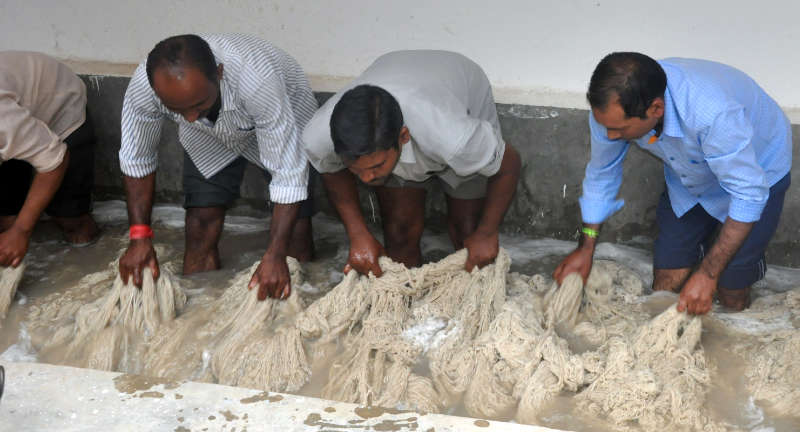
Washing Raw Yarns
All fibers are washed prior to dyeing to remove all dust and make the yarn ready for the best possible color absorption.
When we receive an order for a rug, the raw yarns are pulled from the warehouse and washed in a vat of warm water with gentle soap and kneaded and rotated by foot. The wet yarns are hung on lines to dry in the sun before the dyeing process begins.

Dyeing
Dyeing of the yarns is a true science and the most critical part of the rug-making process.
Highly educated, certified dye masters oversee the process, ensuring that dyes are properly selected and handled, and that colors are exact. As trained chemists, dye masters know the formulas for making each dye color. With their specialized expertise, they can precisely fine-tune a formula for a specific color to work with a specific fiber. Skilled dye masters also know how to prevent issues such as bleeding, running and fading of dyes.
The actual dyeing process is done by placing yarns in large copper vessels set over a burning fire and rotating by hand for several hours until the fibers are fully saturated with pigment. The dyed yarns are then hung outside to dry before being spun into balls and transported to the weaving center.
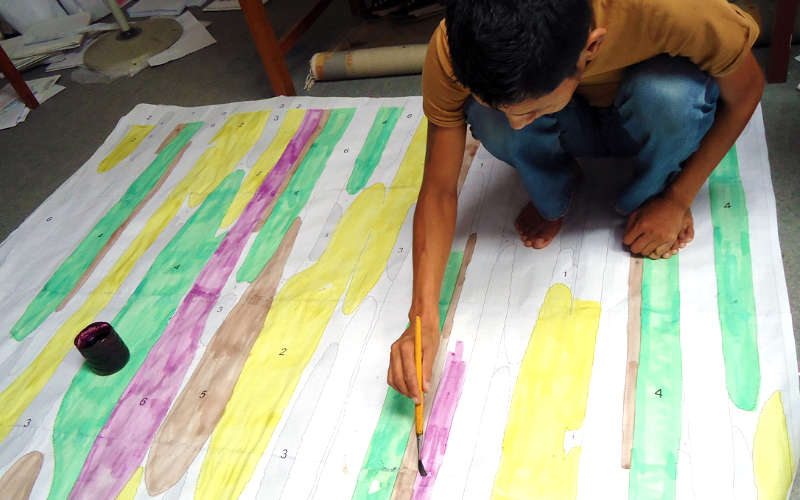
Renderings
Prior to the start of the weaving process, we create and send a detailed rendering of the rug to our overseas factory. The rendering is printed in actual size on large pieces of graph paper. The pieces are glued together and hand painted to identify different areas and colors of the rug. When complete, the realistic full-color, full-scale representation is attached to the top of the loom and used as a road map for the weavers to follow.
On the Loom

The Weaving Process
Weaving a handmade rug on a loom is a centuries-old process that is still used today. Meticulous and time-consuming, the process requires the care and attention of skilled artisans.
There are various techniques used to create a hand-made rug. With hand-knotted rugs, the weaver constructs tiny knots that form the surface of the rug. Creating a room-sized rug requires thousands upon thousands of knots, each individually tied. Depending on the complexity of the design and the size of the rug, the weaving process takes many weeks or months.
Hand-tufted and hand-loomed rugs are constructed using other specific techniques. Regardless of the technique, once the construction process is complete, the finishing work begins.
After the Loom
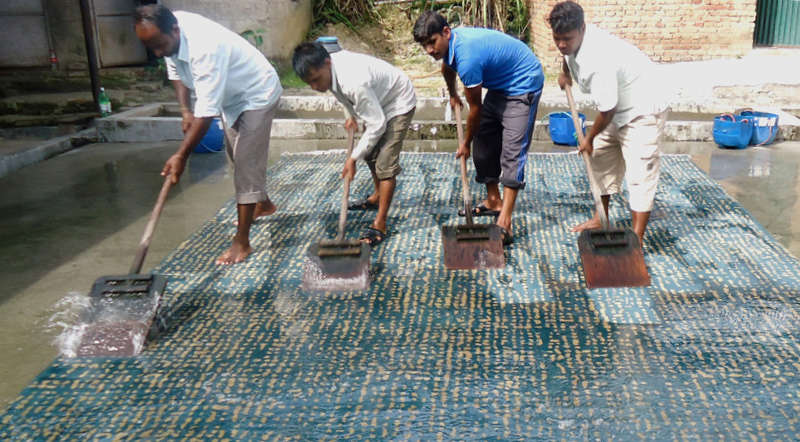
Washing the Rug
Prior to washing, excess fibers are burned off the back. The rug is then washed with wooden paddles, soft brushes and combs to remove excess dyes and any additional fibers. Gentle soap and conditioners enhance the rug’s softness and bring out its sheen and colors. The rug is left in the sun on raised bamboo racks to dry for several days, helping to set the dyes.
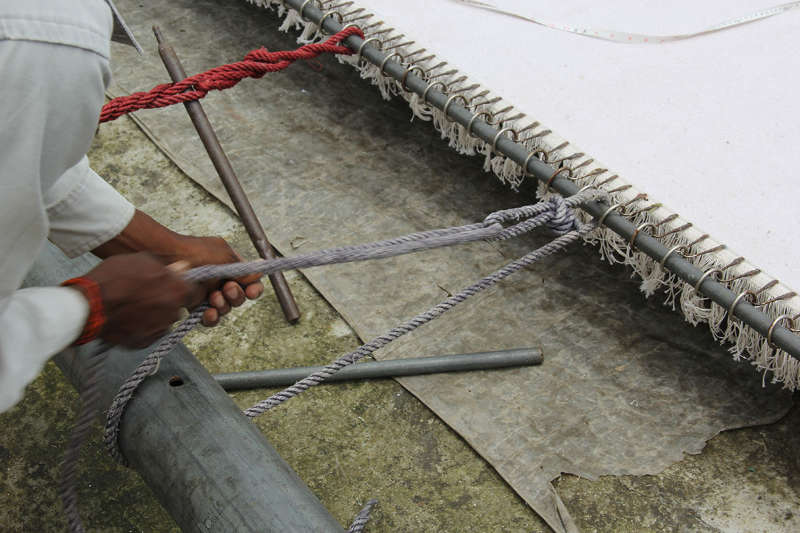
Stretching and Blocking
Hand-spun, hand-knotted rugs are never completely uniform when they come off the loom. To ensure that the finished rug is straight and square, and conforms to the specified dimensions, the dry rug is stretched and blocked.
Stainless steel hooks are placed all around the rug perimeter and pipes are threaded through the hooks to lift the rug onto the stretcher. Our rugs have an additional 2-3” border so that the hooks don’t damage the edge of the rug during stretching.

Finishing
The finishing process involves several steps. For a Tibetan Knot rug, cotton binding is added to each end to maintain smooth edges and prevent soiling.
Next, skilled artisans use sharp scissors to trim the pile and make the surface even. Using smaller, long-pointed scissors, they sculpt between different colors, enhancing the clarity and vitality of the design. The last step is tweezing to remove any loose and foreign fibers from the rug’s surface.
The finished rug is now ready for packing and shipping to our Florida location.
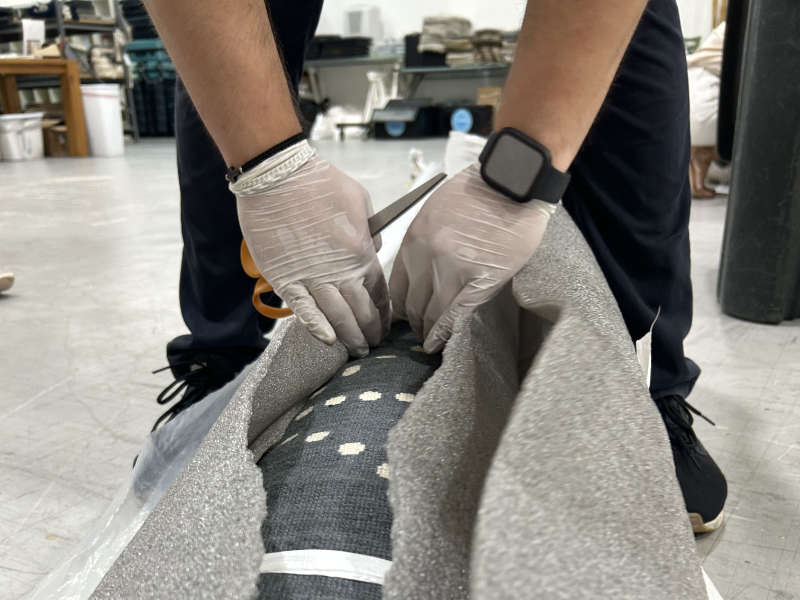
The Final Destination
When the rug arrives at our Hollywood, Florida warehouse, we perform a thorough inspection and apply treatments for stain and / or fire protection as requested.
We carefully package the rug for shipping by rolling it onto a PVC pipe, followed by padding (if ordered), brown construction paper, a layer of Tyvek to protect against abrasion or puncture and, finally, a 6mil plastic sleeve.
Packed securely and ready for shipping, the rug is sent to the designated installer for delivery and set-up in its new home.


